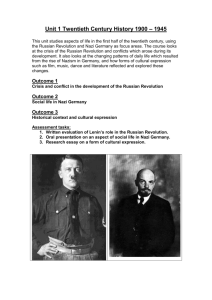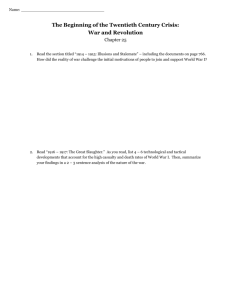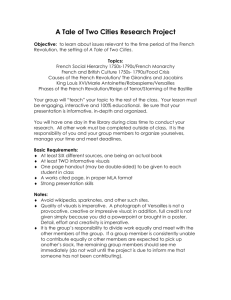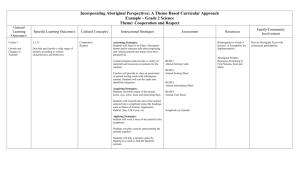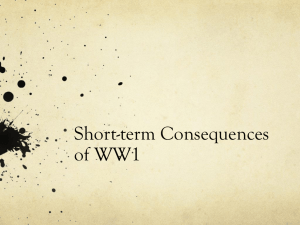Unit 6: World War I and the Russian Revolution (1914
advertisement
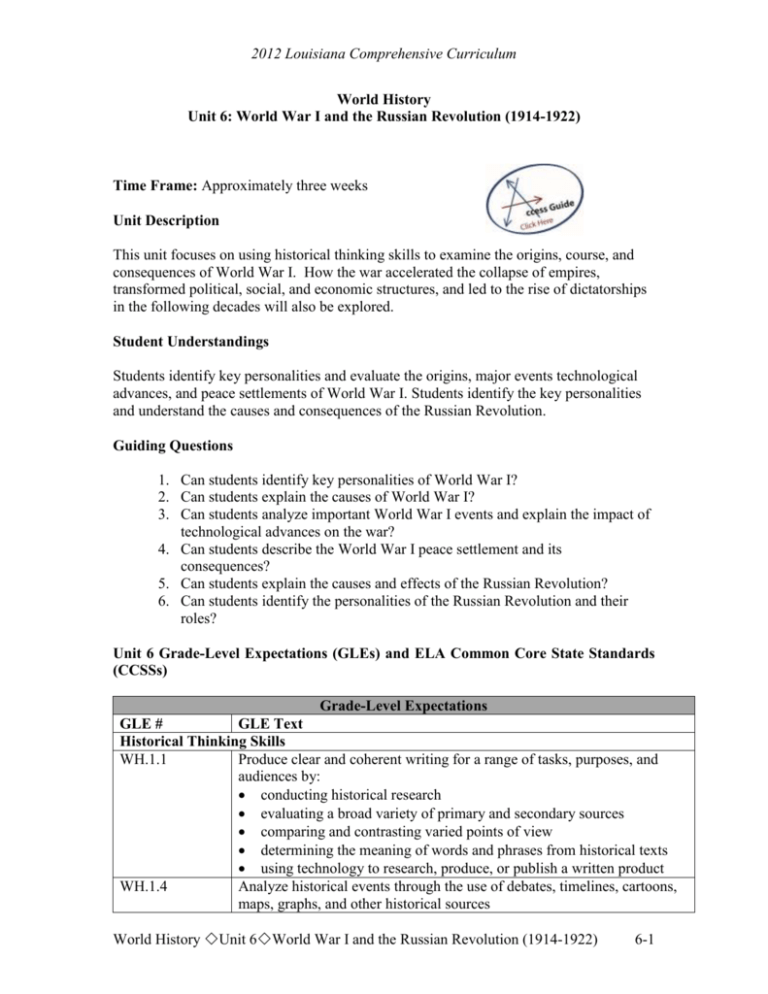
2012 Louisiana Comprehensive Curriculum World History Unit 6: World War I and the Russian Revolution (1914-1922) Time Frame: Approximately three weeks Unit Description This unit focuses on using historical thinking skills to examine the origins, course, and consequences of World War I. How the war accelerated the collapse of empires, transformed political, social, and economic structures, and led to the rise of dictatorships in the following decades will also be explored. Student Understandings Students identify key personalities and evaluate the origins, major events technological advances, and peace settlements of World War I. Students identify the key personalities and understand the causes and consequences of the Russian Revolution. Guiding Questions 1. Can students identify key personalities of World War I? 2. Can students explain the causes of World War I? 3. Can students analyze important World War I events and explain the impact of technological advances on the war? 4. Can students describe the World War I peace settlement and its consequences? 5. Can students explain the causes and effects of the Russian Revolution? 6. Can students identify the personalities of the Russian Revolution and their roles? Unit 6 Grade-Level Expectations (GLEs) and ELA Common Core State Standards (CCSSs) Grade-Level Expectations GLE # GLE Text Historical Thinking Skills WH.1.1 Produce clear and coherent writing for a range of tasks, purposes, and audiences by: conducting historical research evaluating a broad variety of primary and secondary sources comparing and contrasting varied points of view determining the meaning of words and phrases from historical texts using technology to research, produce, or publish a written product WH.1.4 Analyze historical events through the use of debates, timelines, cartoons, maps, graphs, and other historical sources World History Unit 6World War I and the Russian Revolution (1914-1922) 6-1 2012 Louisiana Comprehensive Curriculum Conflict and Resolution WH.6.1 Identify the key personalities and evaluate the origins, major events, technological advances, and peace settlements of World War I WH.6.3 Analyze the causes and consequences of the Russian Revolutions of 1917 ELA CCSS for Literacy in History/Social Studies 6-12 CCSS # CCSS Text Reading Standards for Literacy in History/Social Studies 6–12 RH.11-12.1 Cite specific textual evidence to support analysis of primary and secondary sources, connecting insights gained from specific details to an understanding of the text as a whole. RH.11-12.2 Determine the central ideas or information of a primary or secondary source; provide an accurate summary that makes clear the relationships among the key details and ideas. RH.11-12.4 Determine the meaning of words and phrases as they are used in a text, including analyzing how an author uses and refines the meaning of a key term over the course of a text (e.g., how Madison defines faction in Federalist No. 10). Writing Standards for Literacy in History/Social Studies, Science, and Technical Subjects 6–12 WHST.11-12.4 Produce clear and coherent writing in which the development, organization, and style are appropriate to task, purpose, and audience WHST.11-12.7 Conduct short as well as more sustained research projects to answer a question (including a self-generated question) or solve a problem; narrow or broaden the inquiry when appropriate; synthesize multiple sources on the subject, demonstrating understanding of the subject under investigation. WHST.11-12.10 Write routinely over extended time frames (time for reflection and revision) and shorter time frames (a single sitting or a day or two) for a range of discipline-specific tasks, purposes, and audiences. Sample Activities Activity 1: Origins of World War I (GLEs: WH.6.1, WH.6.3; CCSSs: RH.11-12.4, WHST.11-12.7, WHST.11-12.10) Materials List: World War I Vocabulary BLM, World War I Causes and Effects BLM, Road to World War I Timeline BLM, Europe 1914 Map BLM, crayons or colored pencils, atlas (optional), Internet (optional), primary and secondary sources on the causes of World War I To introduce this activity, have students complete the World War I Vocabulary BLM (see sample below). The vocabulary self-awareness (view literacy strategy descriptions) chart lists many of the relevant terms related to World War I that are not everyday terms with which most students are familiar. Ask students to rate their understanding of each word with either a “√” (understands well), a “?” (limited understanding or unsure), or a “-” (don’t know). World History Unit 6World War I and the Russian Revolution (1914-1922) 6-2 2012 Louisiana Comprehensive Curriculum Students should also write examples and definitions as best they can at this point. Have students refer to the chart as they progress through the World War I content to revise initial entries and update their understanding of the vocabulary. Check the charts throughout the study of World War I to assess student knowledge, and provide additional instruction for students who continue to experience difficulty learning key vocabulary. Word militarism trench warfare + Example Definition Have students work in pairs to research the causes of World War I. Long Term Causes nationalism militarism imperialism system of alliances, Immediate Cause: assassination of Archduke Franz Ferdinand Distribute the World War I Causes and Effects BLM graphic organizer (view literacy strategy descriptions) and ask students to record explanations of the causes in the blocks on the left side (the right side will be completed in another activity). See the World War I Causes and Effects BLM. Lead a class discussion of student responses. As students listen for accurate responses they should change the responses, on their blackline master as needed. Distribute the Road to World War I Timeline BLM (see BLM and sample below). June 28 June 29 Austrian Archduke Franz Ferdinand and his wife are assassinated in Sarajevo, Bosnia, by a Bosnian youth, Gavrilo Princip. Austrian Chief of Staff urges immediate military action against Serbia when speaking to the Austrian Foreign Minister who decides to ascertain the position of Germany. Working in small groups of three or four, have students study the vertical timeline of events and communications from the date of Austrian Archduke Franz Ferdinand’s assassination to the formal declaration of war by Austria against Serbia and Russia (June 28, 1914 to August 6, 1914). Have groups respond to a SPAWN writing (view literacy strategy descriptions) prompt using the Special Powers category. Write the following on the board: You have the power to prevent the start of World War I. Describe steps you would take, why you would take them, and the consequences of that action. Allow time for each group to craft an answer. Monitor groups to ensure full participation by all students. When groups complete their responses to the SPAWN prompt, have each one present to the class. Invite questions and comments from the other students. Provide students with Europe 1914 Map BLM. Working individually or in pairs, have students color or shade the outline map illustrating the nations allied against one another and the neutral countries. World History Unit 6World War I and the Russian Revolution (1914-1922) 6-3 2012 Louisiana Comprehensive Curriculum Students may use their textbooks, an atlas, or the Internet to identify map information. A legend should be created on both maps depicting the colors or shading used for each group of nations (Central Powers, Allied Powers, neutral countries). Students should also label the following: Paris, Tannenberg, Verdun, Marne, Somme, Ypres, and Gallipoli. Ask students to respond to the question: Based upon your labeled and colored map, explain why the alliances were formed. Have students record responses to the question in their learning logs (view literacy strategy descriptions). Have volunteers share their responses with the class. Facilitate any resulting class discussion, and clarify any misconceptions. Activity 2: Battles of World War I (GLEs: WH.1.1, WH.6.1; CCSSs: RH.11-12.2, WHST.11-12.4, WHST.11-12.7, WHST.11-12.10) Materials List: Major Battles of World War I BLM, New Weapons and Tactics of World War I BLM, Internet (optional), primary and secondary sources on the battles of World War I Have students use their textbook or the Internet to research the Schlieffen Plan. Ask students to explain its strategy and the role it played in the early battles of World War I. Divide the class into groups of three or four to research the key battles of World War I. Have groups research the dates, location, primary nations involved, outcome, and significance of each battle. Groups should record their responses on the Major Battles of World War I Chart BLM (see sample below). Battle Dates Location Primary Nations Involved Outcome Significance Tannenburg Each group will present one of the battles to the class. Have students check their responses and make changes to their charts as needed. Encourage each group to use maps, pictures, and/or video clips of the battle they present to enhance the presentations. Suggested battle websites for research are listed below. http://www.firstworldwar.com/battles/index.htm http://www.historylearningsite.co.uk/world_war_one_battles.htm http://www.pbs.org/greatwar/maps/ http://www.spartacus.schoolnet.co.uk/FWWbattles.htm Within their groups, have students research the new weapons and tactics introduced during World War I. Distribute to groups the New Weapons and Tactics of World War I BLM (see sample below). Have groups complete the chart and present their findings. Students should check their responses and make changes as needed. World History Unit 6World War I and the Russian Revolution (1914-1922) 6-4 2012 Louisiana Comprehensive Curriculum Weapon or Tactic Tank Nation that developed the weapon or tactic Effects of the new weapon/tactic British Tanks were able to counter the effectiveness of machine guns and cut through barbed wire entanglements. Eventually, tanks could cross trenches. Have students read about trench warfare in student texts, the Internet, or teacher handouts. After students have completed their readings, they should write a half-page summary describing the reasons for trench warfare, a description of the trench system, and the effects of trench warfare on the soldiers. Suggested trench warfare websites are listed below. http://www.firstworldwar.com/features/trenchlife.htm http://www.spartacus.schoolnet.co.uk/FWWtrench.htm http://www.harrisacademy.com/departments/history/Trenches/Joanna/joanna1.htm http://www.pbs.org/greatwar/chapters/ch1_trench.html Have students complete the following RAFT writing (view literacy strategy descriptions) to assist them in gaining a realistic perspective on life in the trenches, which took a heavy death toll and demoralized the average soldier: Role: A young British soldier Audience: A loved one back home Form: Letter addressed to a loved one Topic: description of life in the trenches Solicit volunteers to share their letters with the class. Students should listen for accuracy and logic in the RAFTs. Facilitate any resulting discussion, and clarify possible misconceptions. Activity 3: Meeting the Major Figures of World War I (GLE: WH.6.1; CCSSs: WHST.11-12.7, WHST.11-12.10) Materials List: World War I Personalities BLM, primary and secondary resources on the major personalities of World War I In groups of three or four, have students research the personalities of World War I listed below. Groups should prepare talking points for each of the following personalities’ perspectives of World War I. Each group should address the person’s role in the origins, major events, and peace settlements of World War I. Groups should also prepare three or four questions to ask the class during their presentations of the personalities. Alfred von Schlieffen Helmuth von Moltke Joseph Jacques Joffre World History Unit 6World War I and the Russian Revolution (1914-1922) 6-5 2012 Louisiana Comprehensive Curriculum Henri-Philippe Petain Georges Clemenceau David Lloyd George Woodrow Wilson Vittorio Orlando Wilhelm II Nicholas II Ferdinand Foch Each group should be given one or two personalities to present to the class. A spokesperson from each group will then deliver the talking points to the entire class, role-playing his/her persona. The rest of the group will field questions from the class regarding this figure. As information about each World War I figure is presented, students should organize and record the presented data on a graphic organizer (view literacy strategy descriptions) (see the World War I Personalities BLM and sample below). Explain how the graphic organizer will help students visually associate the different personalities with specific roles, events, and their impact on the war. WWI Personality Role Event(s) Impact on war Alfred von Schlieffen Close the activity by having students record, in their learning log (view literacy strategy descriptions), which personality they feel had the biggest impact on the war and why. Encourage students to share their responses. Activity 4: Russian Revolutions of 1917 (GLEs: WH.1.4, WH.6.3; CCSSs: WHST.11-12.7, WHST.11-12.10) Materials List: Russian Revolutions of 1917 BLM, chart paper or poster paper for timeline, access to the Internet (optional), primary and secondary resources on the Russian Revolutions of 1917 Place students into small groups of three or four. Have students research the Russian Revolutions of 1917 by using textbooks, primary and secondary resources, and the Internet. Assign each group a topic: Russia during World War I (conditions on the battlefield and at home) Czarist Russia leaders (Nicholas II and Grigori Rasputin) February (March) Revolution of 1917 The Mensheviks and Bolsheviks (leaders and beliefs of each) October (November) Bolshevik Revolution of 1917 (events and outcome) Treaty of Brest-Litovsk (nations involved and provisions) Execution of Czar and his family (reasons and method) World History Unit 6World War I and the Russian Revolution (1914-1922) 6-6 2012 Louisiana Comprehensive Curriculum Civil War (1918-1921) (two sides, events, and outcome) Response of the Allies (side they aided and reasons) Have each group create a presentation, using multi-media where available, to share the research on their topic with the class. As groups present, students should use split-page notetaking (view literacy strategy descriptions) to record the information presented. Distribute to students Russian Revolutions of 1917 BLM (see BLM and sample below). Topics should be written on the left side of the page while important information about each topic is recorded on the right side of the page. Split Page Notes Russia during World War I Remind students that split-page notes can be used for studying for a test by covering one column and using the other to prompt recall of the covered information. To help students understand the importance of the Russian Revolution, have students list and analyze the consequences of the Russian Revolutions of 1917. Their list should evolve as a result of answering the following questions: How did the absolutism of Russian monarchs contribute to the rise of communism and totalitarianism? What is a provisional government, and how does it relate to this revolution? What is communism, and how does it relate to this revolution? Why did the Russians accept the totalitarian rule of Communist dictators? How did the Russian Revolution change feudal society (e.g., collective farms and central planning of the Russian economy)? Close the activity by placing students into groups of three to four in order to create a timeline displaying important events in Russia from the onset of World War I to the creation of the USSR (e.g., February Revolution of 1917, October Bolshevik Revolution of 1917, Russian Civil War, creation of USSR, etc.). Solicit volunteers to share their timelines with the class and explain the importance of the events on their timeline. When completed, have the class informally discuss the following questions: Was Lenin justified in closing down the elected assembly in 1918? Why was the Bolshevik Revolution a significant turning point in world history? What impact did it have on global affairs? Why did the Bolshevik Revolution fail to achieve its goals to defeat capitalism? What are the weaknesses of a centrally planned economy? What are the weaknesses of a totalitarian state? Students should record the questions and answers in their learning log (view literacy strategy descriptions) for future reference when preparing for assessments. World History Unit 6World War I and the Russian Revolution (1914-1922) 6-7 2012 Louisiana Comprehensive Curriculum Activity 5: The United States Enters World War I and the Armistice (GLEs: WH.1.4, WH.6.1; CCSS:WHST.11-12.10) Materials List: United States Enters World War I BLM, Internet (optional), primary and secondary resources on the entry of the United States into World War I and the end of World War I Have students work in pairs to investigate the causes of the United States’ entry into World War I. Distribute to students United States Enters World War I BLM. Students should record the causes for United States entry into World War I on the left side of the blackline master (unrestricted submarine warfare, the Zimmermann Note, and the sinking of the Lusitania should be among the listed causes). The effects should be recorded on the right side by listing the impact the United States entry had on the war (e.g., fresh troops to relieve the war-weary European soldiers, opening of the German blockade to allow supplies to reach the Allies, boost to Allied morale, etc.). Lead a class discussion of responses. Students should make changes to their cause-effect blackline master as needed. Have students work in pairs to create a timeline to show the World War I events of 1918. Students should explain the significance of each event as it relates to the end of World War I. Events should include: signing of the Treaty of Brest Litovsk, arrival of United States troops, 2nd Battle of the Marne, Battle of Chateau-Thierry, Bulgaria and Ottomans surrender, breakup of Austria-Hungary, signing the armistice. After all timelines have been completed, place students into groups of four or five to discuss the timelines. Discussion (view literacy strategy descriptions) can be facilitated using the Round Robin format. Within groups, have each student discuss which events on the timeline were the most significant. Students should justify their choices. After each group member has provided input, the group will decide which event it believes is most significant. Have a student within the group record responses into a well-developed paragraph providing justification for its significant event choice. Each group will present to the whole class. Allow about ten minutes for groups to present, for students to ask questions, and for groups to defend their choice. Record the groups’ responses on the board or overhead projector, and facilitate a class discussion of the events. Timelines can be displayed in the classroom for students to refer to as a study tool. Close the activity by having students record in their learning logs (view literacy strategy descriptions) responses to the following statement: The United States was justified for entering World War I. Explain your answer. World History Unit 6World War I and the Russian Revolution (1914-1922) 6-8 2012 Louisiana Comprehensive Curriculum Have volunteers share their responses. Ask students to listen for accuracy and logic from their peers. Clarify misconceptions when necessary. Activity 6: Treaty of Versailles (GLEs: WH.1.1, WH.6.1; CCSSs: RH.11-12.1, RH.11-12.2, WHST.11-12.4, WHST.11-12.7, WHST.11-12.10) Materials List: World War I Causes and Effects BLM (first distributed in Activity 1), Treaty of Versailles BLM, Reaction to the Treaty of Versailles BLM, copy of Woodrow Wilson’s Fourteen Points, political maps of Europe in 1914 and 1924 Working in pairs or small groups, have students read through the provisions of the Treaty of Versailles and evaluate the impact (success or failure) of each provision. Provide each student with a chart (see the Treaty of Versailles BLM and sample below) to record notes from the analysis. Ask students from each group to share their answers with the class (see the example of answers below). Particular emphasis should be placed on the reparations and war-guilt clauses imposed on Germany. Provisions of the Treaty Germany surrenders all colonies Rhineland demilitarized Conditions of Settlement Colonies become League of Nations mandates 15 year occupation under French control Prediction of Success Severely limits Germany’s access to resources French presence on German soil creates resentment Provide students with a copy of President Woodrow Wilson’s Fourteen Points peace plan to end World War I (Wilson's Fourteen Point Speech 1918). Have students list the provisions of Wilson’s plan using the same wording as the informational text. Ask students to underline any words or phrases about which they have questions. Facilitate class discussion of these terms and phrases. Students should then compare and contrast the Treaty of Versailles with Wilson’s Fourteen Points by using a Venn diagram or some other graphic organizer (view literacy strategy descriptions). Have students work in pairs to investigate the United States’ reaction to the Treaty of Versailles using their textbooks, teacher handouts, or other reliable sources. Then have students answer the following questions: Why was President Wilson unable to persuade the United States Senate to ratify the Treaty of Versailles? What was the Senate’s specific opposition to membership in the League of Nations? How did the United States make its peace with Germany and the other Central Powers? Students should record their responses in their learning logs (view literacy strategy descriptions). Ask students to respond and allow for class discussion. Students should make changes to responses as necessary. World History Unit 6World War I and the Russian Revolution (1914-1922) 6-9 2012 Louisiana Comprehensive Curriculum Have students work in pairs to investigate how the Treaty of Versailles was viewed in the following countries: France, Germany, Austria, Poland, Middle East countries (former Ottoman Empire), Indochina. Students should record their responses on the Reaction to the Treaty of Versailles BLM (see sample below). Lead a discussion of student responses. Students should check their responses and make changes as needed. Countries What did the nation hope to gain from the Treaty of Versailles? What provisions in the treaty directly affected the nation? What was the nation’s reaction to the treaty and why? France Using political maps of Europe in 1914 (click here for a map) and Europe in 1919 (click here for a map), have students analyze the boundary changes after World War I. Ask students to study the maps and answer the following questions: How did the post-World War I boundary changes contribute to the differing views of European countries toward the Treaty of Versailles? How did the boundary changes reflect the role of nationalism in World War I? Students should record their responses in their learning logs. Ask students to respond and allow time for class discussion. Students should make changes to responses as necessary. World War I demonstrated how nationalism could be a very powerful force for change. To help students better understand the power of nationalism, have students write a short essay (100-200 words) that explains how nationalism impacted the United States after September 11, 2001. Students should support their answers with specific examples of nationalism that occurred following that day. Close the activity by having students complete the World War I Causes and Effects BLM that was started in Activity 1. Students should identify effects of World War I by recording them in the boxes on the right side. Suggested responses should include the following: created a world peace organization (League of Nations), created new nations in eastern Europe and the Middle East, severely punished Germany, created political and economic instability which gave rise to dictators. Ask students to respond, and allow time for class discussion. Students should make changes to responses as necessary. Have students respond to the following prompt in their learning logs: Which effect do you believe had the greatest impact on the world and why? World History Unit 6World War I and the Russian Revolution (1914-1922) 6-10 2012 Louisiana Comprehensive Curriculum After students reflect on the question in their learning logs, ask students to share their responses with the class. Facilitate any resulting discussions and clarify any misconceptions. Students should review their vocabulary self-awareness chart (view literacy strategy descriptions) and make changes as necessary. Remind students the chart can be used to prepare for assessment. Sample Assessments General Guidelines Students should be monitored during all activities via teacher observation, log/data collection entries, report writing, group discussion, and journal entries. All student-developed products should be evaluated as the unit progresses. Student investigations should be evaluated with a rubric and when possible, students should assist in the developing of the rubrics used. A variety of performance assessments should be used to determine student comprehension consistent with the type of products resulting from the selected student activities. Teacher-created, comprehensive exams assessing the GLEs from the unit should consist of the following: o a variety of formats for objective, convergent test items o depth of knowledge at various stages of Bloom’s taxonomy o LEAP-like constructed response items o open-ended response items requiring supporting evidence o test items aligned to the verbiage of the GLEs Activity-Specific Assessments Activity #1: Timeline of the Road to World War I should be assessed according to established criteria distributed to students before the timeline activity is begun. Activity #2: Working in small groups of two or three, have each group prepare talking points from the perspective of the historical figures listed in Activity 2 in relation to their roles in World War I. A volunteer from each group should deliver the talking points to the class, role-playing his/her figure’s persona. The rest of the group will field questions from the class regarding the historical figure. Students should be assessed by a predetermined rubric given to students. Activity #6: The nationalism essay should be assessed according to preestablished criteria distributed to students before the map activity is begun. World History Unit 6World War I and the Russian Revolution (1914-1922) 6-11 2012 Louisiana Comprehensive Curriculum World History Unit 6World War I and the Russian Revolution (1914-1922) 6-12
